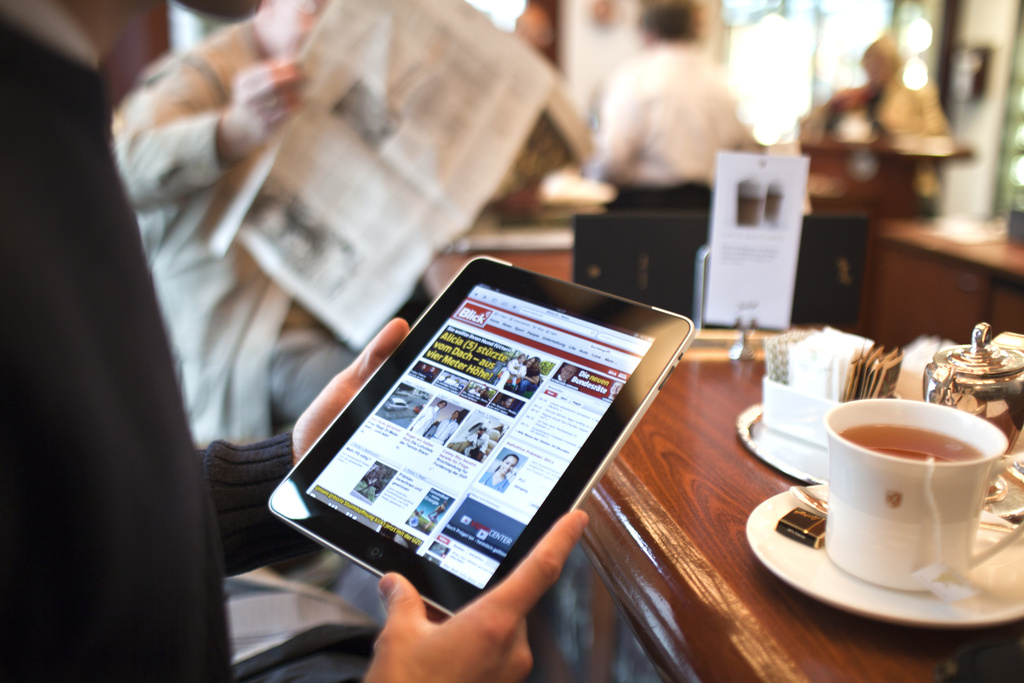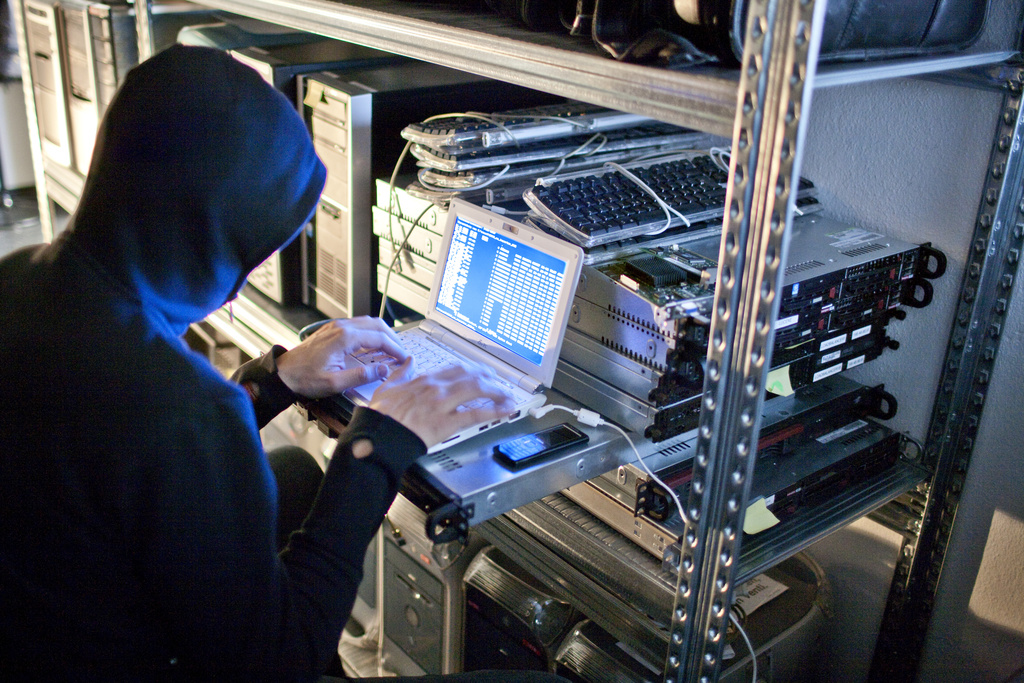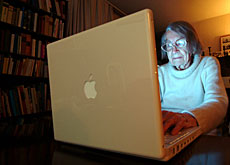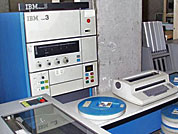Harnessing the potential of tablet technology

A year after Apple released its iPad, Swiss media groups are still grappling with how best to harness its potential.
As free online newspapers have eroded the classified advertising revenues of traditional print editions, media publishers across the globe have been scratching for new ways to entice readers to their mastheads.
The iPad and tablets like it which support paid applications (apps) that mimic the look, if not the feel, of newspapers were seized upon as a potential saviour which would reinvigorate the value of professional journalism as something worth paying for.
Publishers around the world scrambled to develop apps in time for the launch of the iPad in January 2010. Rupert Murdoch’s News Limited group went so far as to develop an iPad-only newspaper, The Daily, which it launched last month.
So have computerised tablets had a significant impact on Swiss media? Peter Hogenkamp, head of online publishing and strategy at Zurich’s NZZ newspaper, told swissinfo.ch the jury was still out on how and where tablet technology would find its place in the market for news media.
Switzerland is described by Hogenkamp and others as an “Apple market”, with more than one million iPhones having been sold to its 7.8 million inhabitants.
But with Apple releasing the second generation iPad in Switzerland on Friday, Hogenkamp remains sceptical that its reach will broaden dramatically in the near future.
He points to its high price as a deterrent (prices range from SFr549 to SFr919 / $600 to $1,000) and estimates fewer than 100,000 of the tablets have been sold in Switzerland to date.
“How can that change the world?” he asked. “I’ve always been surprised that publishing houses have regarded the iPad as a sort of salvation, and they think they will be saved from eroding business models by the iPad.”
Paid or unpaid apps?
Zurich-based Tamedia, one of Switzerland’s largest media groups, launched a range of free iPad apps for its publications to coincide with the launch of the tablet last year.
Christoph Zimmer, head of corporate communications at Tamedia, told swissinfo.ch consumer take-up of the iPad had been significantly less than for the iPhone and the market for tablets remains “very limited”.
“The question for iPad apps is how much do you charge and for which content?” Zimmer said.
The group has released paid apps for weekly publications SonntagsZeitung and Das Magazin.
While it continues to offer the SonntagsZeitung to readers on the internet, Tamedia has removed access to the content of Das Magazin from the internet – readers can access content only through the iPad, iPhone and the print magazine itself.
The company is also preparing to release a paid iPad app for the Zurich broadsheet Tages-Anzeiger next month. It has not yet decided how much to charge for the app which will offer content from the online and print editions, plus some app-only content.
The SonntagsZeitung iPad app is offered as a one-time charge for one edition, or on a subscription basis for one or six months or a year, much like subscription offers for print papers.
Zimmer said the download rate of its paid apps had been “satisfying” and revenues gained had so far covered the cost of developing them.
Connecting with readers
Swiss media group Edipresse, publisher of French-language dailies Tribune de Genève, Le Matin and 24 Heures, last week launched an iPad app for free download to support the Tribune de Genève. It is also preparing to launch shortly free versions for 24 Heures and Le Matin.
Edipresse director of communications Sylvia Wuersten told swissinfo.ch that tablets had an advantage over smart phones because their format is closer to that of a magazine and the larger size makes them easier to read and operate.
“The interactivity of the contents allows for a richer product than print while keeping the concept of a menu and a selective editorial line,” she said. “It is an excellent tool to consolidate the loyalty of print readers through to the digital format.”
Hogenkamp added: “A well-transformed newspaper on an iPad, the experience is definitely closer to the classical newspaper experience compared to a smart phone or the Web.”
Newspapers dominate
According to figures released this week by media research company WEMF, nine out of ten Swiss over the age of 14 read newspapers on a regular basis. Free daily Blick am Abend, a spin-off of the tabloid Blick published by Ringier, recorded a 22 per cent jump in readership in 2010; paid daily Tages-Anzeiger also saw its readership rise.
Zimmer said despite the popularity of smart phones and iPads, its online and print titles were not seeing a decline in readership.
“There are some very good reasons to believe that print will remain dominant,” he said, adding that the online versions of both 20 Minuten and Tages-Anzeiger, despite having relatively large editorial teams, were both profitable.
Hogenkamp agreed and said media companies should look to provide quality content across multiple platforms to retain and attract new readers.
“I’m surprised at how many people see tablets as a separate publishing platform. The idea that newspaper is moving from print to the iPad, I don’t see that at all,” he said.
“I would say that paper will still be around for a long time and if it is replaced, it will be replaced by multiple channels.”
André Bähler of the Swiss consumer protection association told swissinfo.ch he didn’t expect Swiss consumers would be throwing out their old computers quite yet.
“I doubt Swiss habits will change seriously as we already have smart phones and notebooks and can do almost the same things with them,” he said. “This new iPad will not completely replace technologies such as telephone landlines, mobile phones, notebooks and newspapers.”
Motorola: The Xoom is currently best positioned to compete with the iPad 2. With two cameras of 5 and 2 megapixels, this is the first product that works under Android 3, specially designed for tablets. An update will support the Flash format.
Toshiba: Another strong contender, the Toshiba Folio 100 that has a USB port, an HDMI video output and an SD card reader. Android 3 and two cameras for a 10-inch 16/9 screen.
Samsung: The Galaxy Tab is compatible with Flash. It has two cameras and can operate as a phone due to its 3G HSUPA connectivity. But the diagonal is only 17.8 cm compared with the iPad’s 24.6 cm.
Acer sells three tablets of 5, 7 and 10 inches running Android, plus one under Windows 7. For applications, it has its own shop called Alive.
And more: The wide range of tablets includes Archos, Dell’s Streak, HP’s TouchPad and the Playbook by RIM (maker of the Blackberry).
According to research firm Deloitte, 2011 should see the sale worldwide of 375 million smartphones, 200 million laptops, 190 million PCs, 50 million tablets and 40 million netbooks.
Morgan Stanley expects exponential growth in sales of tablets: from 16 million in 2010 to 102 million units in 2013.
The rise of tablets is upsetting the ecosystem of the world of computers that has dominated computers for more than 20 years.
Deloitte estimate that by 2011, more smartphones and tablets will be sold than traditional PCs. JP Morgan expects that 35% of the tablets sold will eat into computer purchases.
(with input from Jessica Dacey)

In compliance with the JTI standards
More: SWI swissinfo.ch certified by the Journalism Trust Initiative




You can find an overview of ongoing debates with our journalists here . Please join us!
If you want to start a conversation about a topic raised in this article or want to report factual errors, email us at english@swissinfo.ch.